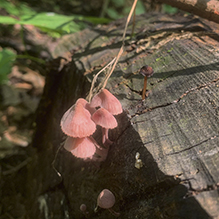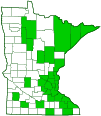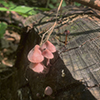Bleeding Fairy Helmet
(Mycena haematopus)
Conservation • Description • Habitat • Ecology • Distribution • Taxonomy
Conservation Status |
|
|||||||
| IUCN Red List | not listed |
|||||||
| NatureServe | NNR - Unranked |
|||||||
| Minnesota | not listed |
|||||||
Description |
||
Bleeding Fairy Helmet is a small, common, widely distributed, bonnet mushroom. It occurs in Europe, North America, Chile, eastern Australia, and Japan. In the United States it occurs in the east from New Hampshire to Georgia, west to Minnesota and eastern Texas, and in the west from western Washington to southwestern California. It is found from spring through fall, usually in dense clusters, sometimes alone or scattered. It grows on hardwood logs that are free of bark and well decayed. It rarely grows on coniferous logs. It obtains its nutrients from decaying wood (saprobic). When it first appears, the cap is oval to bell-shaped and reddish to brownish-red, reddish-brown, or pinkish brown. It is dark in the center and lighter near the margins. The surface is dry, rough to the touch (scurfy), and dusted with fine powder. The margin often extends beyond the gills. As it ages the cap expands and becomes bald. Mature caps can be convex or nearly flat and ⅜″ to 2″ (1 to 5 cm) in diameter, but they are usually broadly cone-shaped or broadly bell-shaped and no more than 1⅜″ (3.5 cm) in diameter. The margins are sometimes shallowly lined or grooved. On older specimens the edges are usually toothed, lobed, or scalloped. The gills are closely spaced and may be broadly attached or narrowly attached to the stalk. They are whitish at first, becoming grayish or purplish with age. They sometimes develop reddish-brown stains, and they stain reddish-brown when bruised. The edges are cottony white. Between the main gills there are frequent short gills that attach to the margin but do not extend all the way to the stalk. The stalk is fragile, hollow, 1¼″ to 3″ (3 to 8 cm) long, and 1⁄32″ to ⅛″ (1 to 3 mm) thick. It is brownish-red to reddish-brown or nearly purple, and sometimes has scattered hair-like fibers (fibrils). On young specimens it bleeds a purplish-red latex when broken. The flesh is thin, fragile, and colored like the cap or paler. It bleeds a purplish-red latex when cut. It is edible but tasteless and insubstantial. The spore print is white. |
||
Similar Species |
||
Habitat and Hosts |
||
Decayed hardwood |
||
Ecology |
||
Season |
||
Spring through fall |
||
Distribution |
||||
|
Sources |
|||
| 11/23/2022 | ||||
Occurrence |
||||
Common |
||||
Taxonomy |
|||
| Kingdom | Fungi (Fungi) | ||
| Subkingdom | Dikarya | ||
| Phylum | Basidiomycota (Basidiomycete Fungi) | ||
| Subphylum | Agaricomycotina (Higher Basidiomycetes) | ||
| Class | Agaricomycetes (Mushrooms, Bracket Fungi, Puffballs, and Allies) | ||
| Subclass | Agaricomycetidae | ||
| Order | Agaricales (Common Gilled Mushrooms and Allies) | ||
| Suborder | Marasmiineae | ||
Family |
Mycenaceae | ||
Genus |
Mycena (bonnets) | ||
Synonyms |
|||
Agaricus haematopus Galactopus haematopus Mycena haematopoda |
|||
Common Names |
|||
Bleeding Fairy Helmet Bleeding Mycena Burgundydrop Bonnet |
|||
Glossary
Saprobic
A term often used for saprotrophic fungi. Referring to fungi that obtain their nutrients from decayed organic matter.
Visitor Photos |
|||||
Share your photo of this fungus. |
|||||
| This button not working for you? Simply email us at info@MinnesotaSeasons.com. Attach one or more photos and, if you like, a caption. |
|||||
Honey Fae (Farah) |
|||||
 |
|||||
MinnesotaSeasons.com Photos |
|||||
|
|||||

Slideshows |
||

Visitor Videos |
|||
Share your video of this fungus. |
|||
| This button not working for you? Simply email us at info@MinnesotaSeasons.com. Attach a video, a YouTube link, or a cloud storage link. |
|||
Other Videos |
|||
| Bleeding Fairy Helmet Mushroom [Mycena haematopus] Jack of All Clades |
|||
About
Sep 23, 2020 this is the bleeding fairy helmet mushroom Mycena haematopus. When this mushroom is damaged it leaks out a blood like liquid that looks pretty cool. So it's pretty easy to see where this mushroom gets its name. |
|||
| La seta que sangra, a bleeding Mycena, Mycena haematopus 4K he wonderful world of mycology |
|||
About
Nov 7, 2020 Nature is always giving us precious things, such as mushrooms of the genus Mycena. I have been looking for this mushroom for years that I present to you today, and this year I have finally found it on several occasions. It is a curious Mycena, since when cutting it a red latex bleeds, as you can see in the video. When you get into the world of mushrooms, more and more, you stop thinking with your stomach, to think with your heart. This and other species that I have been showing you, make you forget about day-to-day problems, to enjoy the moment. Happiness is given by little moments like this. Mycena haematopus (Pers.) P. Kumm. 1871 Characteristics |
|||
| Bleeding Mushroom Find In Nature - mycology, fungi |
|||
About
Dec 26, 2019 This is a bleeding mushroom, a mushroom that bleeds after being cut. If you like it, subscribe for more: https://www.youtube.com/channel/UCVP-MWBmKG_wxepwZahh8eQ . Burgundydrop Bonnet (Mycena haematopus) is an interesting Mycena that bleeds when you cut it. This bleeding mushroom that grows on wood of deciduous forests, is a Mycena that is easily identified in the field. The other Mycena that bleeds is the Bleeding Bonnet (Mycena sanguinolenta) but that one grows on the ground in conifer woods. |
|||

Created: 11/26/2022
Last Updated:


